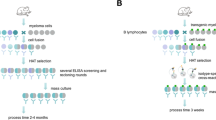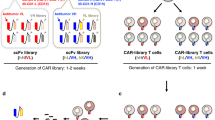Abstract
THERE is currently a great deal of interest in binding sites (receptors) on lymphocytes with respect to their role: (a) for recognition of antigens, (b) as “trigger sites” for lymphocyte differentiation and proliferation, (c) as markers of the type and specificity of antibodies that the progeny of the cell will produce if stimulated, and (d) in regulating whether immunity or tolerance is induced by exposure to the antigen1–3. The well defined antigenic structure of immunoglobulins makes it possible to look for the presence of immunoglobulin-type receptors using anti-immuno-globulin sera. The interaction of anti-immunoglobulin antibodies with small lymphocytes in cell culture stimulates nucleic acid synthesis and the transformation of lymphocytes to blast cells5. We have used this approach to investigate the phenotypic expression of H-chain controlling genes in lymphocytes. Stimulation of nucleic acid synthesis in vitro by specific anti-H-chain sera was used as a criterion for the presence of receptors with μ or γ-chain specificity on lymphocytes.
This is a preview of subscription content, access via your institution
Access options
Subscribe to this journal
Receive 51 print issues and online access
$199.00 per year
only $3.90 per issue
Buy this article
- Purchase on Springer Link
- Instant access to full article PDF
Prices may be subject to local taxes which are calculated during checkout
Similar content being viewed by others
References
Dresser, D. W., Immunology, 9, 261 (1965).
Mitchison, N. A., Cold Spring Harbor Symp. Quant. Biol., 23, 431 (1967).
Gell, P. G. H., Cold Spring Harbor Symp. Quant. Biol., 23, 441 (1967).
Sell, S., Rowe, D. S., and Gell, P. G. H., J. Exp. Med., 122, 823 (1965).
Gell, P. G. H., and Sell, S., J. Exp. Med., 122, 813 (1965).
Ling, N. R., and Holt, P. J. L., J. Cell Sci., 2, 57 (1967).
Sell, S., J. Exp. Med., 125, 393 (1967).
Adinolfi, M., Gardner, B., Gianelli, F., and McGuire, M., Experientia, 23, 271 (1967).
Van Furth, R., Schuit, H. R. E., and Hijmans, W., Immunology, 11, 19 (1966).
Van Furth, R., Schuit, H. R. E., and Hijmans, W., Immunology, 11, 29 (1966).
Cerny, J., Ivanyi, J., Madar, J., and Hraba, T., Fol. Biol., 11, 402 (1965).
Lobb, N., Curtain, C. C., and Kidson, C., Nature, 214, 783 (1968).
Herzenberg, L. A., Herzenberg, L. A., Goodlin, R. C., and Rivera, E. C., J. Exp. Med., 126, 701 (1967).
Author information
Authors and Affiliations
Rights and permissions
About this article
Cite this article
SKAMENE, E., IVANYI, J. Lymphocyte Transformation by H-Chain Specific Anti-immunoglobulin Sera. Nature 221, 681–682 (1969). https://doi.org/10.1038/221681a0
Received:
Revised:
Issue Date:
DOI: https://doi.org/10.1038/221681a0
This article is cited by
Comments
By submitting a comment you agree to abide by our Terms and Community Guidelines. If you find something abusive or that does not comply with our terms or guidelines please flag it as inappropriate.



